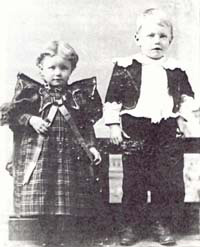

Sigga and Bill Christianson, c. 1897
Dr. Sigridur (Sigga) Christianson Houston

By C. Stuart Houston, originally printed as “A pioneer woman doctor, Sigga Christianson Houston," Manitoba Medicine, 63 (2) June 1993.
Dr. Sigridur (Sigga) Christianson, MD (Manitoba 1925), Saskatchewan’s oldest living medical doctor, at 100 years, is a product of the ferment of her time, for all sorts of revolutionary ideas were abroad in the land. Women thought they should be allowed to vote, to own property, to enter fields previously restricted almost entirely to men. They might even qualify as ‘persons’! In Canada, Manitoba was the pre-eminent focus of these ideas, considered extremist by some. The Icelandic women were more active in the cause than any other immigrant group.
Sigga’s father, Geir Christianson (born 23 May 1860), a journeyman carpenter from the fishing village of Hafnarfjördur, just south of Reykjavik, Iceland, emigrated to North America around 1890. (A Canadian immigration officer spelled the surname phonetically and the incorrect spelling stuck. It should have been Kristjansson). Times were tough in Iceland, following volcanic eruptions that covered the sheep grazing areas. Before emigrating, Geir had worked in the Skagafiordi hay fields in northern Iceland, part of the labour-intensive crew turning over the freshly mowed hay, so susceptible to rot in that damp climate. One summer he had worked alongside Sesselja Rakel Sveinsdottir (born 12 August 1857), the sixth of 13 children of Svein Asmundsson and Sigridur Jonsdottir whose farm, Starrastadir, was 15 km south of Varmalhid. The next haying season she wasn’t there, and he learned that she had emigrated to ‘America’. Geir arrived in Winnipeg (the “second largest Icelandic city in the world” after Reykjavik); family tradition says he had only 25 cents left in his pocket when he arrived.
Geir’s immigrant train was welcomed by a large group of Icelanders. Did anyone know where Sesselja Rakel was, he inquired. The question buzzed up and down the line. “Já, já” (pronounced yow, yow). Someone knew. Sesselja Rakel was a maid in the hotel at Pembina, on the Red River south of Winnipeg, a mile or two below the forty-ninth parallel in North Dakota. Geir went at once to Pembina, sought out Seeslja Rakel, and soon they were married.
A son, Bill, born 25 March 1892, and three daughters joined the family. Sigga, the oldest girl, born 28 June 1893, was an outstanding student. Halldora (Dora) followed on 13 January 1896 and Bjorg (Babs) on 28 January 1898.
As a carpenter in the booming town of Grand Forks, Geir had steady summer employment at 25 cents an hour, but only odd jobs in the winter. Before long he built a modest home and Sesselja took in boarders to supplement their income.
In 1905, the lure of free land at Vatnbygg [sic] was too much for Geir. He joined hundreds of Icelanders who homesteaded in the Wynyard-Mozart area of Saskatchewan. Geir, a fisherman’s son filed on 160 acres and took a pre-emption to the saline ‘dead sea’ named Big Quill Lake.
The soil was poor, drinking water had to be hauled from five miles away, and it was a 12-mile trip to the aspen woods where he went yearly to cut wood for fuel. Geir knew nothing about farming, but his carpentry skills put food on the table whenever he got a contract to build a nearby school. On the occasions after good rains, when a promising crop appeared, Geir would ‘go into hock’ with the Massey Harris company for new machinery, only to be hailed or frozen out before the wheat was in the bin. He was constantly in debt.
Sigga’s younger siblings were delighted with the freedom of the farm. They loved living in a tent the first summer while Geir prepared their house, which measured 12 by 16 feet downstairs, and rested on a stone cellar. Compared with the neighbour’s shacks, it was considered a castle. A family photo from around 1909 showed the family beside the possession of which they were most proud, a large woodpile. But Sigga, aged 12, was devastated. There was no school for her to go to in the first year, after which she was able to complete grades 7 and 8 at the new Mountain School. That’s all there was. In Grand Forks, her mind had been set on going to university. Sigga was undaunted.